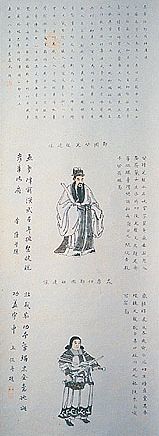Zheng Zhilong

Zheng Zhilong ( Chinese 鄭芝龍 , Pinyin Zheng Zhilong , W.-G. Cheng Chih-lung ; * 1592-1595 in Shijing , province of Fujian , China ; † 24. November 1661 in Beijing ), also known by the nickname Yiguan or iquan known , was a Chinese merchant , pirate, and admiral who exerted great influence in the transition from the Ming to the Qing dynasties .
Life
Macau
Around 1610, Zheng began an apprenticeship with his uncle, a trader named Huang Cheng, in the Portuguese settlement of Macau , where he helped him sail ships on routes to Japan and Southeast Asia. During his time in Macau, Zheng was baptized and given the Christian name Nicholas Gaspard (or Nicolas Jaspar ). He was friends with some priests and learned from them the Portuguese language , which functioned as an important lingua franca in East Asian waters .
Hirado
His career as a trader or pirate began in southern Japan under the care of Li Dan ("Captain China"). Li Dan was a leading Chinese trader in Hirado who controlled the illegal trade between Hirado and Xiamen . As the Ming continued to forbid trade between China and Japan, the Japanese ports in Hirado, Nagasaki and Tanegashima were playgrounds for European and Asian smugglers . After Li's death in 1625, Zheng took over his fleet and continued his business.
Admiral and privateer
In the 1620s, Zheng relocated his operations to the Fujian area, where one of the main routes of Chinese sea trade ran and where, like many other pirate captains, he made great fortune. In 1628 the Ming government offered him a position as admiral - a tried and tested tactic at the time to keep piracy under control. Armed with official powers, Zheng left his rivals behind and rose to become the leader of a powerful naval fleet.
He also had an ambivalent alliance with the Dutch East India Company in Taiwan . The Dutch were interested in gaining access to the Chinese market and preventing Portuguese and Spanish supremacy in regional trade. As a business and diplomatic liaison with the Ming, and since he attacked Spanish ships as a privateer, he was of double use in achieving the Dutch goals. In the late 1620s, Zheng controlled trade between Taiwan and Fujian. In the 1630s and early 1640s he was probably the most influential Chinese in Asian waters.
Prince of Tang and Death
When Beijing, the capital of the Ming Dynasty, was captured by the Manchus in 1644 , Zheng supported the Ming Prince Zhu Yujian , also known as the Prince of Tang, in Fujian Province as a candidate for the imperial throne. When the Manchu army won an overwhelming victory in central China two years later, Zheng switched sides and, as a result, was showered with titles and high offices by the Qing government. His son Zheng Chenggong (also known as Koxinga), who was a famous pirate who controlled Formosa Island (Taiwan), refused to surrender to the Qing troops. As a result, Zheng Zhilong was arrested and dismissed from office in 1655. In 1661 he was executed for his son's stubborn resistance.
Works
- Jingguo xionglue ("Great Strategy for Commanding the Land"), military manual, 1645
See also
literature
- Tonio Andrade: The Company's Chinese Pirates: How the Dutch East India Company Tried to Lead a Coalition of Pirates to War Against China, 1621–1662 . In: Journal of World History . tape 15 , no. 4 . University of Hawai'i Press, 2004, pp. 415-444 , doi : 10.1353 / jwh.2005.0124 .
- Tonio Andrade: Lost Colony: The Untold Story of China's First Great Victory over the West . Princeton University Press, New Jersey 2011, ISBN 978-0-691-14455-9 .
- Xing Hang: Conflict and Commerce in Maritime East Asia: The Zheng Family and the Shaping of the Modern World, c. 1620-1720 . Cambridge University Press, Cambridge 2015, ISBN 978-1-107-12184-3 .
Individual evidence
- ^ Xing Hang: Conflict and Commerce in Maritime East Asia: The Zheng Family and the Shaping of the Modern World, c. 1620-1720 . Cambridge University Press, Cambridge 2015, ISBN 978-1-107-12184-3 , pp. 41-42 .
- ↑ a b c Zheng Zhilong. In: Encyclopædia Britannica . Retrieved August 8, 2017 .
- ^ A b c Xing Hang: Conflict and Commerce in Maritime East Asia: The Zheng Family and the Shaping of the Modern World, c. 1620-1720 . Cambridge University Press, Cambridge 2015, ISBN 978-1-107-12184-3 , pp. 42-43 .
- ^ A b Andrew R. Wilson: The Maritime Transformations of Ming China . In: Andrew Erickson (Ed.): China Goes to Sea: Maritime Transformation in Comparative Historical Perspective . Naval Institute Press, Annapolis, Maryland 2009, ISBN 978-1-59114-242-3 , pp. 269 .
- ^ Adam Clulow: The Company and the Shogun: The Dutch Encounter with Tokugawa Japan . Columbia University Press, New York 2014, ISBN 978-0-231-16428-3 , pp. 181 .
| personal data | |
|---|---|
| SURNAME | Zheng Zhilong |
| ALTERNATIVE NAMES | Yiguan (nickname); Iquan (nickname); Nicholas Gaspard (baptismal name); Nicolas Jaspar (baptismal name) |
| BRIEF DESCRIPTION | chinese pirate |
| DATE OF BIRTH | between 1592 and 1595 |
| PLACE OF BIRTH | Shijing , Fujian Province |
| DATE OF DEATH | November 24, 1661 |
| Place of death | Beijing |